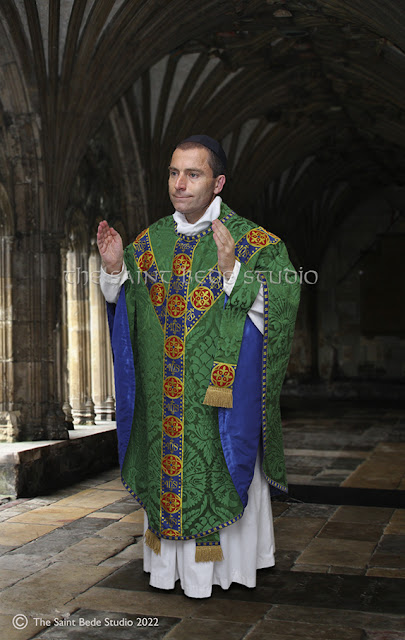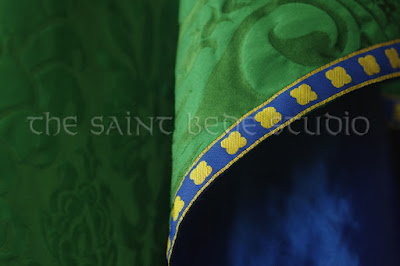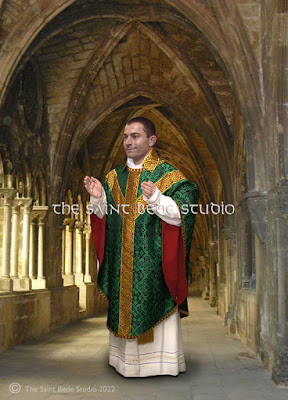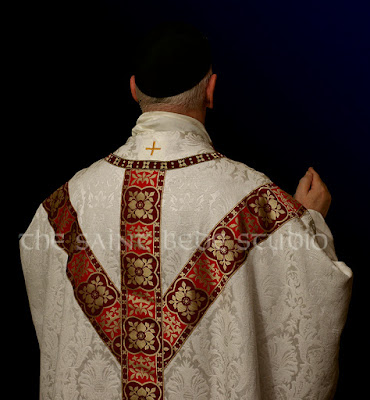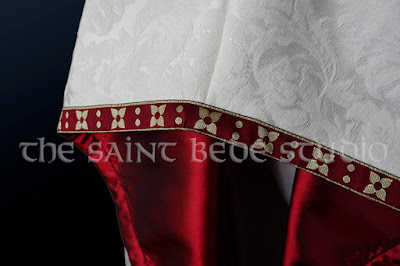LOOKING AT "AD ORIENTEM "
FROM A DIFFERENT DIRECTION
by Michael Sternbeck
INTRODUCTION
In 2016, as a result of a paper given at a liturgical
conference in London by Cardinal Sarah - in those happier days when he was Prefect of the Congregation for Divine Worship - an unpleasant public kerfuffle broke
out, with Cardinals and Curial officials contradicting each other about the direction
the celebrant should (or might) face when offering Mass according to the
Ordinary Form of the Roman Rite. An
interesting, but unconvincing debate (1) ensued on the precise meaning of
the General Instructions of the Roman Missal in order to prove (or disprove)
the point that the "normative direction" for the celebration of the
Ordinary form is ad orientem and versus populum is the
"exception".
 |
Figure 1.
Pope Paul VI offering Low Mass ad orientem
before a vast crowd in Saint Peter's Square in 1963.
Versus populum celebrations increasingly became
the usual form of Papal Mass during his reign. |
Despite little victories of textual meaning, the
reality is that - so far as the practice of the Church is concerned - the
"normative" direction is versus populum. It had been so increasingly in Papal Rome from the moment
Pope Paul VI offered Mass versus populum on the occasion of his Coronation in Saint
Peter's Square on 29th June 1963. Throughout
the rest of the 1960's leading up to the publication of the new Roman Missal in
1970, (2) Pope Paul increasingly offered Mass versus populum,
signifying that he wished to establish this as the normative practice for the
Roman Church. (3) Throughout the Latin Church, very few
resisted this new direction.
We might regard the practice of celebrating Mass versus populum as the product of a particular (dated) liturgical
philosophy and based on imperfect scholarship. The fact remains, however, that worldwide, the majority of
celebrants and the Faithful are quite comfortable with versus populum celebrations of the Mass and do not see any reason to
change. We might take this a step
further and observe that Liturgical Tradition is not prominent in the
consciousness of every, or even most Catholics. Perhaps the younger generation - which has no interest in
the outdated causes of the 1960s - is more disposed to it. With that hope, we have prepared this
paper, an expansion of small posts which previously have appeared on the blog
of the Saint Bede Studio. This article is not intended to be an apologia for the celebration of the Ordinary Form of the Mass of the Roman Rite ad orientem; a large number of scholars have done this very ably. Its intention is to clarify certain misconceptions about both ad orientem and versus populum celebrations.
THE ALTAR : THE EARTHLY FOCUS OF THE MASS
“The
altar of holy Church is Christ, as John testifies, when he says in his
Apocalypse that he saw him as a golden altar standing before the throne. In him and through him the gifts of the
faithful are offered to God the Father.”
 |
Figure 2.
Mass celebrated in the Benedictine Abbey
Church of Brugges, Belgium.
The Church is oriented, the altar being
free-standing and resting in the apse
beneath a stone canopy. |
This extract from the old Roman Pontifical for the Ordination of
subdeacons elucidates the teaching of the Church that the altars of our churches
signify Christ, although Christ himself is at once the priest, victim and Altar
of Sacrifice. The distinguished
theologian and liturgist, Canon A. Croegart, emphasises the primacy of the
altar:
“Without the eucharistic sacrifice, there would be no
communion; without communion, there would be no reserved sacrament, nor any of
the other forms of devotion connected with the worship of the reserved
sacrament. Everything depends upon
the altar, yet this order of importance is all too frequently ignored.”
Croegart’s conclusion is obvious, yet startling:
“The altar is not an ornament of the church, but
rather, the church is an architectural ornament housing and covering the
altar. The jewel does not exist
for the casket, but the casket is adapted to and serves the jewel...Therefore,
it is important that the altar should be prominent in the church. By its central position and
sumptuousness, the altar should, straightaway, draw the attention of those who
enter the church.” (4)
This is the Church’s ancient and continuing understanding of the nature
of the altar and its relationship to the celebration of Mass.
WHAT IS “AD ORIENTEM”?
Simply translated, the Latin term ad orientem means “towards the east”. One of the meanings of the word orientation is “the action of turning to or facing the east”. To pray facing the East was not an
invention of Christianity, it was a custom common to Jewish and Pagan worship
alike, although not universal.
Ancient peoples faced the rising sun to pray, in some cases identifying
it as a deity. Where the sun rose
was considered by ancients to be the place from where life, power and happiness
came. But the books of the Old
Testament also contain many references to orientation and facing towards
Jerusalem for prayer. Cleansed of
pagan notions, and enriched by the expectation of Christ appearing in the East
at the Second Coming, orientation became part of Christian prayer, both public
and private, from the earliest times.
By the reign of the Emperor Constantine in the early fourth century, when
Christianity emerged from persecution, the celebration of the Sacred Mysteries
was almost invariably oriented.
 |
Figure 3.
Floorplan of the typical arrangement
of the basilican-style church found
from the fourth century. |
The floorplans of the public churches which began to be constructed in
the Constantinian period, situate the cathedra
or chair of the bishop in an apse and facing eastward. Often, benches for presbyters were
arranged on either side of the bishop’s chair. Standing forward of these seats, at the entrance to the
apse, was the usual position for the altar, standing freely, and often covered
by a canopy or ciborium. The foregoing is often referred to as the basilican arrangement of churches and it was common in the East and West of Christendom, with significant regional variations.
It was this basilican arrangement
which was used to justify the introduction of the celebration of Mass, versus populum in the 1960s. That this was based on faulty
understandings of the early liturgy has become widely accepted in more recent
years. During the ancient celebration
of the Sacred Mysteries in these basilican
churches, the celebrant and the faithful would all face eastward, not each
other. Orientation was the
essential and consistent element.
Some churches in this early period were also built in the opposite
direction, so that the celebrant and the faithful, whilst facing east, were
turned towards the apse, not the entrance to the church. This was the arrangement of churches
which became typical in the East and the West down through the centuries until
the versus populum revolution of the
1960s.
THE USE OF THE CHAIR BY THE PRIEST-CELEBRANT
Although there is a great deal of discussion now and a body of
scholarship concerning the revival of the celebration of the Roman Rite Mass ad orientem, it may be
observed that this discussion is largely limited to the Liturgy of the Eucharist in the Ordinary
Form of the Roman Rite. Yet, the
principle ought to concern the orientation of Liturgical prayer throughout the
entirety of the Mass.
Amongst the many innovations introduced immediately following Vatican
Council II was a provision (Ritus Servandus 1965, no. 23) for the
celebrant to pray the Kyrie, Gloria, Collect and Creed at a sedilia,
rather than at the altar (as had previously obtained). This provision, of course, was derived
from the practice where a bishop celebrated Mass solemnly, either at the
faldstool or at the throne. The
1965 provision was taken a step further with the introduction of the new Missal
in 1970.
 |
Figure 4.
The Conventual Mass celebrated at the Benedictine Abbey
of Le Barroux, France.
At this moment, the celebrant is singing the Collect
not from the altar but at the sedilia,
attended by the deacon and subdeacon. |
Dom Emmanuel OSB, a monk of the Abbey of Le Barroux (France), gave a paper to the 1997 CIEL Conference about this topic. In a comprehensive analysis of available liturgical texts stretching back into the first millenium, in which is discussed firstly the position of the celebrant during the Kyrie, Gloria, Collect and Creed and secondly, the position of the celebrant during the readings from the Scripture, Dom Emmanuel reached these two conclusions:
Having finished our enquiry we may now answer this
question: as far we can judge from the texts currently available, the Roman
Mass, both according to the use of the [Roman] Curia and those of the dioceses
and religious orders, show us that the simple priest is at the altar for the Gloria,
the Collect and the Creed, and that this is the case until
1962. So, the Ordo Missae of
1965 departs from the common (and almost universal) practice up to that point
when it prescribes that the simple priest may carry out these functions at his
seat.
[However,] by having the celebrant positioned at the sedilia for the
readings, the Ordo Missae of 1965 (and then that of 1970) [does] not depart from what we know of Roman
usage (taken as a whole) through the centuries. (5)
Dom Emmanuel's study and of course many other works on liturgical
history, reveal that in the early church (and we know that from archaeological
evidence as well the ancient churches which still exist) the Cathedra of the
bishop was mostly placed in the apse, behind the altar, with benches for the
presbyters on either side. This
was a position, as Dom Emmanuel concludes, which emphasised the jurisdiction of
the Bishop. He argues, however,
that it never was
customary in the Western liturgy for the priest-celebrant to occupy such a
position, because he did not have jurisdiction.
 |
Figure 5.
The High altar of the Italian Cathedral of
Saint Nicolas, Bari rests beneath
a twelfth century civory or canopy.
Behind the altar is the eleventh century
cathedra of the bishop : centrally located,
but almost invisible to the faithful. |
Instead, as Dom Emmanuel discusses, the priest celebrant recited the Kyrie, the Gloria and the Collect at
or near to the altar and ad orientem. But
there were examples where the celebrant might be seated during the
lessons. Similarly, a bishop who
did not have jurisdiction occupied a seat on the right side of the altar, but
read the above prayers from that position ad orientem (for example,
the rites of Pontifical Mass at the faldstool according to the Extraordinary
Form, namely the 1962 Missale Romanum).
Another important point might be made : most (but not all) examples of cathedra which have survived in this
central position reveal that the chair of the bishop was not significantly elevated above the altar, which was built in
front of it and upon its own steps.
Consequently, in this arrangement, the bishop's chair would not have been completely visible to the Faithful
during the Liturgy. The point of
this is that the chair of the bishop was (more usually) not
positioned centrally to facilitate communication
with the Faithful, as has been suggested in recent decades.
CELEBRANT OR PRESIDER?
What we would like to emphasise is that an entirely new concept was introduced
into the 1970 Order of Mass, namely, the priest-celebrant as “Presider”.
This seems nowhere more prominent in the New Order of Mass than in the Introductory Rite: the arrangement of which is an
innovation in the history of the Western liturgy. In the 1970 Order of Mass, the Introductory Rite included the Celebrant's Greeting, the Penitential Rite, the Gloria and the Collect. This new-fashioned role of Presider is codified by the instruction on the placement of the celebrant’s
chair within the sanctuary: namely at the head of the sanctuary in an apse; in
short behind the altar:
The chair of the celebrant should indicate his role of
presiding over the assembly and of leading the prayers. Hence the most suitable position is at
the head of the sanctuary facing the people, unless the construction of the
building or other circumstances prevents this; for instance, if communication
between the priest and the assembly of the faithful is made difficult because
of too great a distance. General Instruction on the Roman Missal
no.271.
 |
Figure 6.
This plate appeared in a children's Mass-book
from the late 1960s. It shews a priest
celebrating Low Mass and praying the
Collect at the sedilia, on the right
side of the sanctuary, not the altar.
See also plate 7. |
This particular instruction represents not a revival
of an ancient liturgical practice, but a misrepresentation of it. Notably absent from the instruction is
an obvious opportunity to emphasise that, with the chair placed behind the altar and the Faithful
seated in front of the altar, both
the Celebrant and the Faithful are turned
towards the altar to pray. Instead
we find the word “communication”.
We would like to suggest that this particular break
with Tradition has largely facilitated the widespread distortion where, from
the very beginning of the Mass, the priest becomes more of a compere or emcee,
rather than a celebrant.
TOO MANY WORDS
The principle of the intelligibility of the Church's rites is
the liturgical philosophy which underpins the 1970 Missale Romanum and was enunciated in
the Vatican II constitution Sacrosanctum
Concilium. One of the great presuppositions
made by the reformers in the 1960's was that the most important way during Mass
for us to communicate with God and for God to communicate with us is by the spoken word. Happily,
this presupposition is being challenged more and more.
The New Order of Mass or Ordinary Form of
the Roman Rite is very wordy. This
is not to say that the Extraordinary Form (1962 Missale Romanum) has fewer words, but it certainly has
fewer words that are to be prayed aloud and
intended as a form of “communication” with the gathered Faithful. Whatever about more recent developments in the manner of
celebrating the Ordinary Form, it was devised with the intention that it be for
the most part - and usually spoken -
not sung. (6)
 |
Plate 7.
Part of the sanctuary of the church featured
in plate 6. This unknown Belgian church,
built during the early 1960's, was intended
for the celebration of Mass versus populum.
It is noteworthy, however, that Mass
could just as readily be offered ad orientem
because of the ample size of the
altar platform.
The setting is quite dignified in the modern
style. |
The principle of communication is most prominent in the Ordinary Form in what is termed The Introductory Rite. Here, the predominance of dialogue between the “presider” and the “assembly”
lays. It is for this reason
precisely that the incorporation of ad
orientem posture is
desirable from the very beginning of the Order and not simply during the
Liturgy of the Eucharist. It is
desirable because it would have the effect of lessening the prevailing tendency
that the Mass is a dialogue (which varies from place to place in degrees of
formality) between those physically present in a particular church, rather than
being the worship of the entire Church, Visible and Invisible.
The former Prefect of the Congregation for Divine Worship, Cardinal Sarah spoke
about this very matter in a 2015 interview reproduced in the L'Osservatore Romano :
Contrary to what has at times been sustained, and in
conformity with the Conciliar Constitution, it is absolutely fitting that
during the Penitential Rite, the singing of the Gloria, the orations and
Eucharistic Prayer, for everyone – the priest and the congregation alike – to
face ad orientem together,
expressing their will to participate in the work of worship and redemption
accomplished by Christ. This way
of doing things could be fittingly carried out in the cathedrals where the
liturgical life must be exemplary. (7)
ADOPTING “AD ORIENTEM” IN STAGES
Various proposals (8) that the celebration of the Ordinary Form of Mass may
be divided into being partly ad orientem (for the Liturgy of the Eucharist) and partly versus populum (for the Liturgy of the Word) are not an adequate
solution or compromise.
Already, some pastors through the catechesis of their
flocks, have introduced the celebration of the Ordinary Form ad orientem and
have been doing so for some time. But
not every pastor of souls is in a position to do this. Leaving aside the issue of prudence, the
sanctuaries of some churches are not readily suited to this arrangement, namely
that the celebrant offers the Liturgy of the Eucharist at the altar facing
towards the apse. For these two
reasons, suppose the focus were not on the Liturgy of the Eucharist, but on a
partly ad
orientem Liturgy of the Word?
What might be done, to recapture the Church's
tradition at this point in the Ordinary Form of the Roman Rite
Mass? In many places, this has
begun already to happen, where priests have felt uncomfortable with the
prominence of their (often elevated) chairs, and have opted to place the chair
at the side of the sanctuary in front of the altar, in the manner of sedilia. We have also read where some priests
with chairs in the position just described, have turned slightly toward the
altar (rather than toward the congregation) for the Penitential rite, Gloria and Collect. All of this would seem to be able to take place within the
current framework of the Ordinary Form. It also does not exclude the celebrant giving a brief
introduction to the Mass, but it might be hoped that this is quite distinct
from the prayers of the Rite itself.
 |
Plate 8.
Recitation of the Creed during the
celebration of Mass according to
The Anglican Use of the Roman Rite. |
Late in 2015, the new Missal for the Personal
Ordinariates Anglicanorum
Coetibus was published.
It is titled Divine Worship : The
Missal. This Missal was
prepared with the full approbation of various Roman dicasteries, so that it is
an approved usage of the Roman Rite.
Some have called it the Anglican
Use of the Roman Rite. At its
heart is a very different form of the Order of Mass, a composition which in
part is the Extraordinary Form of the Roman Rite, in part the Ordinary Form of
the Roman Rite and in part certain prayers found in the Book of Common Prayer
and other Service Books published within the Anglican Communion in the 20th
century. Not only are the prayers
of its Order of Mass different from that of the Ordinary Form of the Roman
Rite, but so are its ritual actions.
Ad orientem celebrations of
its Order of Mass are designated as the normative
form. In time, this Anglican Use Order of Mass will have its
effect on celebrations of the Roman Rite, even unofficially so.
Let us consider what such an effect on the Ordinary
Form of the Roman Rite might be:
- Instead of praying the Penitential Rite at the chair, the celebrant might conduct the Penitential Rite ad orientem “at the foot of the altar”, and then go up to stand at the altar for the Kyrie, Gloria and the Collect.
- Then the celebrant could go to the sedilia and sit down for the reading of the Scripture. He would bless the deacon (and incense, if it used) at the altar, not the sedilia.
- After the Gospel, the celebrant might return to the altar and pray the Creed followed by the General Intercessions (both ad orientem).
It is quite important to note that these ceremonial
adjustments might be used even if the Liturgy of the Eucharist continued to be
celebrated versus populum. Might this be a gradual and pastorally-considerate way of
re-introducing ad orientem to the entire Ordinary Form Roman
Mass?
Perhaps the suggestions above might be too radical for some, not sufficiently
covered by existing permissions and customs or not desirable for pastoral
reasons at present. Perhaps the
time is not yet here for such modifications, but they might at least be pondered. Suppose, however, that just
one moment ad
orientem, were considered opportune for the Liturgy
of the Word … just one, which does not cause too much consternation or nervousness.
If the Creed were
sung or recited by the celebrant and the congregation together, the celebrant
standing ad orientem at
the centre of the altar or at the base of the steps leading to the altar :
suppose that were to be introduced? It would surely not be so very controversial, in addition to
being a powerful symbol.
IN CONCLUSION
Whilst it may well be argued that many
priests and congregations would not welcome ad orientem celebrations of the Liturgy of the
Eucharist, surely fewer would object to parts of the Liturgy of the Word being
celebrated ad
orientem, particularly
if such a practice were introduced slowly and in stages and with appropriate catechesis.
 |
Plate 9.
A Conventual Mass according to the New Missal
in the Abbey-Church of Sant'Antimo, Tuscany.
|
As a
principle, prayers addressed to God during the Liturgy of the Word of the Ordinary Form might be
offered ad orientem and
preferably at the altar or its foot, in order to clarify that such prayers are not a dialogue between the celebrant and the faithful present. A gradual introduction of this principle could (over a period of
years) lead to the celebration of the Ordinary Form of Mass being entirely (or
mostly) ad orientem. Already a variant of the Roman Rite exists
which puts into effect this principle, namely the Order of Mass prepared for
the use of the Personal Ordinariates Anglicanorum
Coetibus in the United Kingdom, the USA/Canada and Australia.
Under the Copyright of
The Saint Bede Studio
November 2017
END-NOTES
(1) The blog Dominus Mihi Adjutor
https://hughosb.com/2016/07/12/the-fallout-and-propaganda-cardinal-sarah-and-sacra-liturgia-2016/
(2) The New Order of Mass was authorised for use from 1st
Sunday of Advent, 1969. The first
typical edition of the Missale Romanum
was published in 1970. Although
some approved translations of the Propers of the New Missal in English existed
from 1972, it was not until late 1974 that the entire Roman Missal in English was
printed by various publishing houses.
(3) We leave to one side here the obvious point that within the
Patriarchal Roman basilicas the celebration of Mass was traditionally versus populum because the altars within
these basilicas were free-standing and faced eastward down the nave, not
towards the apse.
(4) Canon A. Croegart, The Mass: A Liturgical Commentary (vol.
1), 1958, pp. 4-5.
(5) The veneration and
administration of the Eucharist : the proceedings of the second international
colloquium on the Roman Catholic liturgy organised by the Centre International
d'Etudes Liturgiques. Translated and edited by members of CIEL UK. The Saint Austin Press, Southampton,
1997.
(6) After the Introduction of the New Order of Mass in November 1969,
Pope Paul seems not to have “sung” Mass again. Typically (but not always), the Preface and Lord’s Prayer
were sung at the Papal Mass, but the celebrant’s parts of the Liturgy of the
Word, the Canon, the Collect, Secret and Postcommunion prayers were all spoken. The same applied to Paul’s Successors,
with the exception of the Pope Benedict.
(7) The Blog Rorate Caeli
https://rorate-caeli.blogspot.com/2015/06/exclusive-rorate-translation-cardinal.html
(8) Website of The Catholic Herald
http://www.catholicherald.co.uk/issues/july-15th-2016/we-can-have-it-both-ways/
This paper, first published on the weblog of the Saint Bede Studio in 2017, is presented again in the earnest desire to contribute something positive to the movement for the Reform of the Roman Liturgy.
That in all things, God may be glorified.







